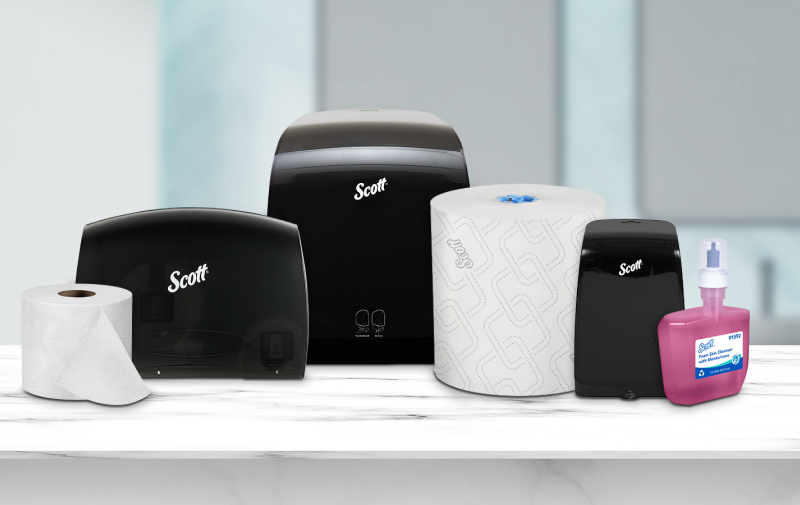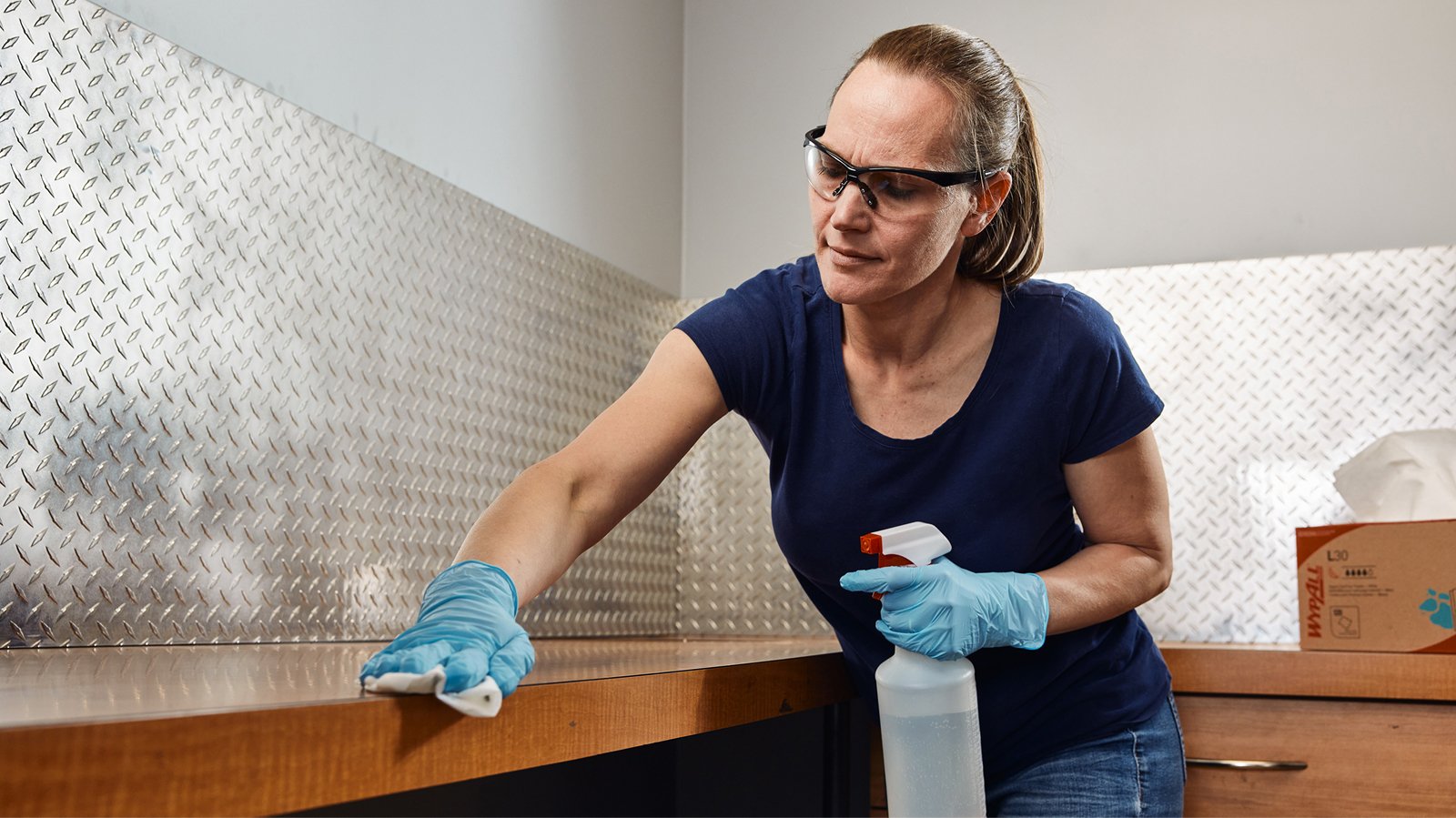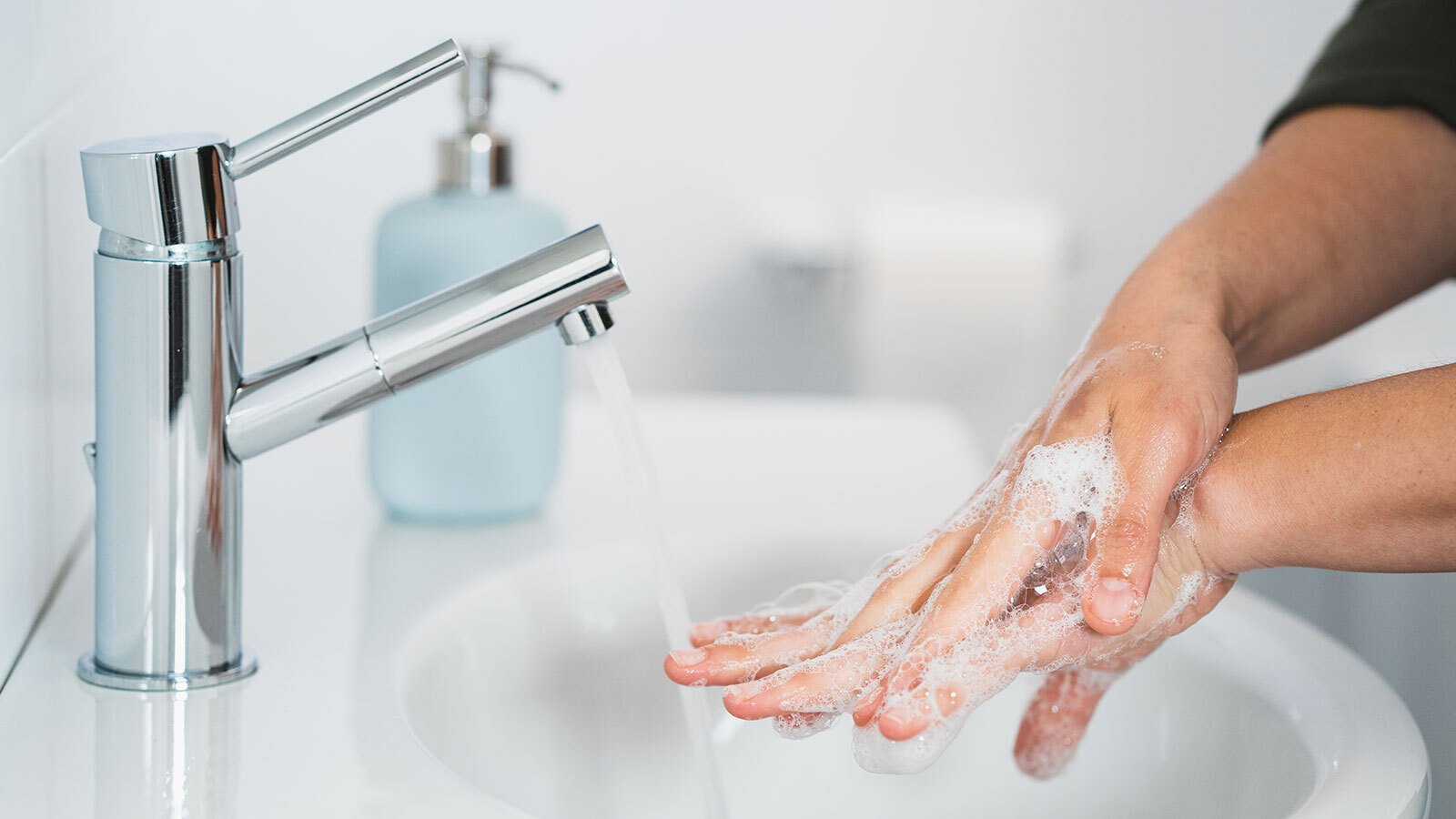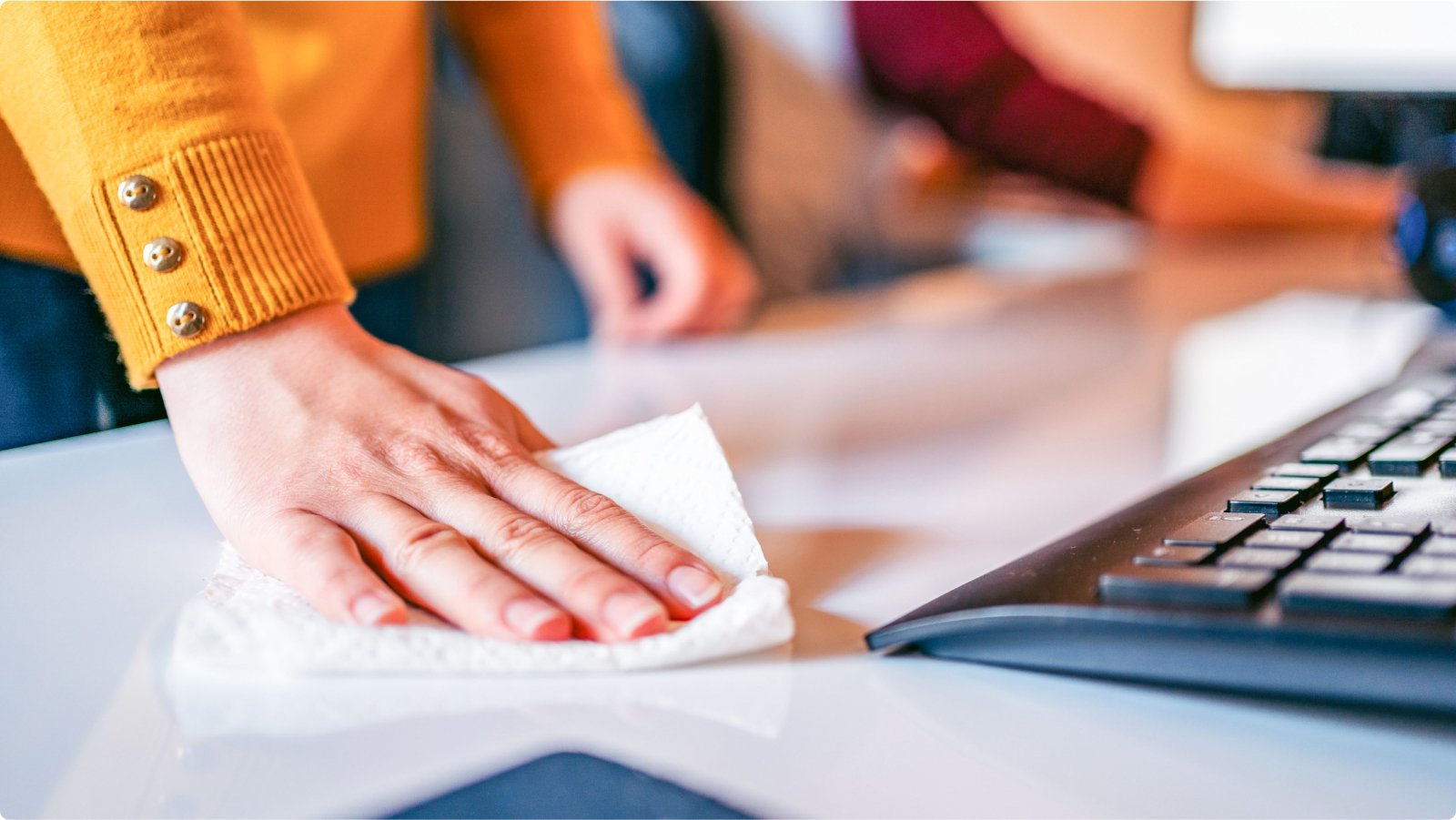Last Updated JUNE 2024
Jet Air Dryers vs. Single-Use Paper Towels: Which is More Effective for Restroom Hygiene?
Uncover the surprising truth: single-use paper towels outshine jet air dryers as a more effective method of drying hands and helping to reduce germ transmission. Explore the science, convenience and sustainability factors behind their effectiveness. Discover why paper towels are the champions of restroom hygiene.

Navigating the Hand-Drying Debate
A clean restroom isn't just about appearances; it's crucial for the well-being of patrons and employees. In a world where safety standards are broadening to include hand and surface hygiene, the way we dry our hands is gaining newfound importance.
Enter the ongoing debate: paper towels versus jet air dryers.
While hand dryers are often advertised as the solution to cross-contamination, reality tells a different story. The
crux of the matter? There's a gap between human behavior and effective solutions as studies show a staggering 95% of
adults fail to wash their hands long enough, leaving behind lingering bacteria and germs even after
handwashing.1
This is where single-use paper towels shine. Positioned as a practical and proven solution, they offer a simple approach to addressing this behavioral gap.
Let's delve into the science behind it all and uncover why paper towels emerge as the most effective method for drying hands* — the unsung heroes of restroom hygiene.

How Clean Restrooms Contribute to Good Health
Does promoting hand hygiene in away-from-home environments truly make a difference? The answer is, yes. Numerous studies have investigated the potential impact of hand hygiene interventions in office environments.
The findings from these studies show benefits such as:
- Reduction in germ transmission
- Fewer reported cases of illnesses for respiratory and gastrointestinal infections
- Decreased insurance claims
- Lower rates of absenteeism2
According to the CDC, the ripple effects of handwashing resonate throughout the community, with a decrease in common illnesses such as colds by 21% and diarrhea by 31%. Also, for those with compromised immune systems, it shows a decrease of 58% in diarrheal illness.3
Creating an environment that prioritizes the well-being of both patrons and employees means more than just meeting regulatory standards — it requires a commitment to providing a clean and hygienic facility.
At the core of this endeavor lies the restroom, where implementing simple yet effective measures can significantly enhance overall hygiene and well-being.
4 Reasons Why Paper Towels Are More Effective than Jet Air Dryers
Efficacy
Using a hand dryer may seem like a quick solution, but it often falls short in thoroughly drying hands. It can take a minute or longer to fully dry your hands using a hand dryer, but many people only spend 30 seconds using it — half the necessary time for thorough drying.
As a result, people often leave restrooms with their hands still moist, unknowingly spreading bacteria onto door handles and other surfaces as they exit.
Paper towels have been proven to effectively remove up to 77% of bacteria that might remain after handwashing.4
Research strongly supports using single-use paper towels as the more hygienic hand-drying method*, particularly in environments prioritizing hygiene. Paper towels have been proven to effectively remove up to 77% of bacteria that might remain after handwashing.4
Drying hands with paper towels not only speed up the drying process but also utilizes friction to dislodge any remaining bacteria.5
Convenience
In busy restrooms, people may feel pressured to rush through or even skip the handwashing process. Unfortunately, incomplete drying poses a significant risk, as damp hands can spread up to 1,000 times more bacteria than dry hands.6
When faced with a line for hand dryers, many will bypass the entire process and leave with wet hands or wipe them on their clothing — compromising the effectiveness of handwashing and contributing to the spread of germs.
Single-use paper towels offer a straightforward solution to these challenges. With no waiting required, individuals can quickly grab a paper towel from the dispenser, dry their hands as they exit and dispose of the towel before leaving the restroom.
This efficient process ensures thorough hand drying, helping to minimize the risk of bacteria transmission and promoting optimal hygiene practices.
Cross-Contamination
Cross-contamination is a significant concern in restroom hygiene, and paper towels offer a clear advantage in addressing this issue. Unlike hand dryers, which expel high-velocity air, dispersing whatever contaminants are on a patron's hands throughout the restroom, paper towels keep bacteria contained within the towel.7
Studies have shown that jet air dryers can disperse up to 1,300 times more germ particles into the surrounding air compared to paper towels. Even after 15 minutes, the air remains significantly more contaminated when hand dryers are used.8
In contrast, paper towels effectively prevent airborne transmission by confining bacteria, and patrons typically dispose of them before leaving the restroom. This straightforward disposal method helps minimize the spread of germs and contributes to a cleaner restroom environment.
Bacterial Growth
Despite handwashing, wet surfaces remain susceptible to bacterial growth, even on hands deemed hygienic. Some powerful hand dryers, such as jet air dryers, have been shown to expel water droplets containing bacteria and viruses as far as 6.5 feet away. These droplets can linger in the air for up to 15 minutes, posing a risk of cross-contamination.9
Paper towels effectively remove moisture, reducing the likelihood of bacterial growth. The physical act of rubbing hands with paper towels also helps to eliminate germs that may not have been removed during washing.5
This proactive approach removes moisture effectively and helps mitigate the introduction of additional bacteria in the hand-drying process.
Some powerful hand dryers, such as jet air dryers, have been shown to expel water droplets containing bacteria and viruses as far as 6.5 feet away.
Hygiene FAQs
Are paper towels sustainable?
Paper towels can represent a sustainable option, influenced by several factors including the materials used and the type of dispensers. Today, paper towels created from 100% recycled paper are widely available.
For example, Kimberly-Clark Professional offers products under the Responsible Partners portfolio that are compostable and help contribute to reducing greenhouse gas emissions (GHGs), among other environmental benefits.
The choice of dispensers also plays a crucial role in sustainability efforts. Automatic dispensers that provide a controlled amount of paper can contribute to cost savings and minimize waste, highlighting the connection between efficiency and sustainability.
Some suppliers even offer take-back recycling programs as incentives. This allows customers to return used dispensers or other hygiene products at the end of their life cycle, ensuring proper disposal and enabling these products to be repurposed into new consumer goods.
How does hand sanitizer facilitate good hand hygiene?
Hand sanitizer containing at least 60% alcohol is a good addition to any hand hygiene routine. It plays a key role in maintaining hand hygiene between handwashing opportunities, for the general public.10
For healthcare workers, frequent use of hand sanitizer may be preferred over constant handwashing with soap and water. However, certain infections require handwashing with soap and water to ensure thorough cleanliness, so healthcare workers should follow protocols around specific infections and hand hygiene methods.
Does it matter if I use antimicrobial soap?
Simply put, no. For the general public, no studies have yet demonstrated an added health benefit to using antimicrobial soaps compared to other soaps.
The science behind washing hands with soap is that the surfactants within soap combined with water and friction create a lather that loosens germs, dirt and any other soil from the skin. After scrubbing, the loosened germs and dirt are rinsed off the skin with running water.
So, the focus should be on proper handwashing technique and duration rather than relying on antimicrobial soap.11
Advocating for Effective Hand Hygiene
It's important to recognize that air dryers are not inherently unsanitary; rather, they amplify a prevalent issue in human behavior—people don’t wash their hands thoroughly, leaving bacteria behind. Moist hands provide an ideal environment for bacteria to thrive and transfer onto surfaces.
Because of this, single-use paper towels stand out as champions of hand hygiene, offering a reliable solution to ensure hands are thoroughly dried and help curb the spread of germs.
This is why we advocate for single-use paper towels over air and jet dryers as the optimal hand-drying method, promoting a healthier environment for all.

Ready to elevate your restroom experience?
Explore our suite of trusted restroom solutions to help increase productivity, reduce waste and improve employee and customer satisfaction.
1Cp, B., J, C., & S, K. (2013, April 1). Hand Washing Practices in a College Town Environment. Journal of Environmental Health. < https://pubmed.ncbi.nlm.nih.gov/23621052 />
2Zivich, P. N., Gancz, A. S., & Aiello, A. E. (2018). Effect of hand hygiene on infectious diseases in the office workplace: A systematic review. American Journal of Infection Control, 46(4), 448-455. https://doi.org/10.1016/j.ajic.2017.10.006; Arbogast, J. W., Moore-Schiltz, L., Jarvis, W. R., Harpster-Hagen, A., Hughes, J., & Parker, A. (2016). Impact of a comprehensive workplace hand hygiene program on employer health care insurance claims and costs, absenteeism, and employee perceptions and practices. Journal of Occupational and Environmental Medicine, 58(6), e231–e240. https://doi.org/10.1097/jom.0000000000000738; Kurgat, E. K., Sexton, J. D., Garavito, F., Reynolds, A., Contreras, R. D., Gerba, C. P., Leslie, R. A., Edmonds-Wilson, S. L., & Reynolds, K. A. (2019). Impact of a hygiene intervention on virus spread in an office building. International Journal of Hygiene and Environmental Health, 222(3), 479–485. https://doi.org/10.1016/j.ijheh.2019.01.001; Reynolds, K. A., Beamer, P. I., Plotkin, K. R., Sifuentes, L. Y., Koenig, D. W., & Gerba, C. P. (2015). The healthy workplace project: Reduced viral exposure in an office setting. Archives of Environmental & Occupational Health, 71(3), 157–162. https:// doi.org/10.1080/19338244.2015.1058234; Hovi, T., Ollgren, J., & Savolainen-Kopra, C. (2017). Intensified hand-hygiene campaign including soap-and-water wash may prevent acute infections in office workers, as shown by a recognized-exposure adjusted analysis of a randomized trial. BMC Infectious Diseases, 17(1). https://doi.org/10.1186/s12879-016-2157-z
3CDC. (2021, June 3). Hand Hygiene at Work. Centers for Disease Control and Prevention. < https://www.cdc.gov/handwashing/handwashing-corporate.html#:~:text=Good%20hand%20hygiene%20means%20regularly >
4Redway, K. (October 2010). Changes in the number of different types of bacteria on the hands before and after drying using paper towel, continuous cloth roller towel, warm air dryer and jet air dryer. University of Westminster https://europeantissue.com/wp-content/uploads/WU-Study-2010-Report.pdf
5Huang, C., Ma, W., & Stack, S. (2012). The Hygienic Efficacy of Different Hand-Drying Methods: A Review of the Evidence. Mayo Clinic Proceedings, 87(8), 791–798. https://doi.org/10.1016/j.mayocp.2012.02.019
6Alharbi, S. A., Salmen, S. H., Chinnathambi, A., Alharbi, N. S., Zayed, M. E., Al-Johny, B. O., & Wainwright, M. (2016). Assessment of the bacterial contamination of hand air dryer in washrooms. Saudi Journal of Biological Sciences, 23(2), 268–271
7Moura, I. B., Ewin, D., & Wilcox, M. H. (2021). From the hospital toilet to the ward: A pilot study on microbe dispersal to multiple hospital surfaces following hand drying using a jet air dryer versus paper towels. Infection Control & Hospital Epidemiology, 1–4. https://doi.org/10.1017/ice.2021.43
8Kimmitt, P. T., & Redway, K. F. (2016). Evaluation of the potential for virus dispersal during hand drying: a comparison of three methods. Journal of Applied Microbiology, 120(2), 478–486. https://doi.org/10.1111/jam.13014
9Best, E. L., & Redway, K. (2015). Comparison of different hand-drying methods: the potential for airborne microbe dispersal and contamination. Journal of Hospital Infection, 89(3), 215–217. https://doi.org/10.1016/j.jhin.2014.11.007; Best, E. L., Parnell, P., & Wilcox, M. H. (2014). Microbiological comparison of hand-drying methods: the potential for contamination of the environment, user, and bystander. Journal of Hospital Infection, 88(4), 199–206. https://doi.org/10.1016/ j.jhin.2014.08.002; Visscher, M. O., & Randall Wickett, R. (2012). Hand hygiene compliance and irritant dermatitis: a juxtaposition of healthcare issues. International Journal of Cosmetic Science, 34(5), 402–415. https://doi.org/10.1111/ j.1468-2494.2012.00733.x
10CDC. (2022, June 15). Keeping Hands Clean. Center for Disease Control and Prevention. https://www.cdc.gov/hygiene/personal-hygiene/hands.html#:~:text=Use%20Hand%20Sanitizer%20When%20You,of%20germs%20in%20most%20situations
11CDC. (2021, August 10). Show Me the Science - How to Wash Your Hands. Centers for Disease Control and Prevention. https://www.cdc.gov/handwashing/show-me-the-science-handwashing.html; CDC. (2020, September 9). Frequent Questions About Hand Hygiene. Centers for Disease Control and Prevention. https://www.cdc.gov/handwashing/faqs.html





















